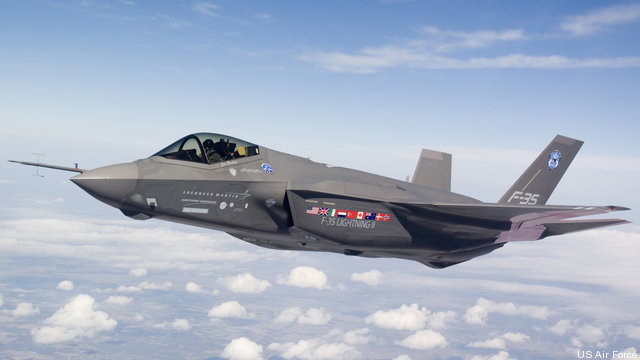Cartwright Targets F-35, AirSea Battle; Warns of $250B More Cuts
Posted on

VIRGINIA BEACH, VA: The Pentagon should brace for another $250 billion or more in cuts even if sequestration does not occur and must revolutionize how and what it buys, warned Hoss Cartwright, former vice-chairman of the Joint Staff, in a speech that savaged sacred cows from the Joint Strike Fighter to cybersecurity to the AirSea Battle concept.
“We just took a $480-some billion reduction” in the current budget proposal, Cartwright said at the annual Joint Warfighting Conference hosted by the US Naval Institute and the industry group AFCEA. (Click here for video). “While we squeal a lot about that reduction, we were heading that way anyway,” he said. Whether sequestration occurs or not, the pattern of past post-war drawdowns strongly suggest we’re heading further down the budget cutting road. “$480 billion is about a 10 percent reduction,” he said. “Historically we’ve run about 20% reductions after these conflicts. We’re about halfway there.”
That means “we’ve got at least another increment of a couple hundred [billion],” Cartwright went on. “If you take another two hundred billion out of this budget, we’re going to start to run into a problem if you don’t start thinking about the strategy,” he said. “You really need strategy before you spend money, and what you spend it on needs to be something you can actually afford.”
On the ground, the current strategy is one shaped by a decade of optimization for operations from static bases in Afghanistan and Iraq. “We are now an occupation force,” Cartwright said. “When you go to battle by getting up in the morning in your compound, getting into your armored vehicles, go out and patrol, and return to your compound at night, that is an occupation force.” With all its armored vehicles, its body armor, and — equally important — its massive logistical tail, “it is a very heavy force, too heavy to move by air,” he said. So if the Marine Corps and Army recapitalize their ground vehicle fleets without reconceptualizing them, they will lack the agility that future operations require.
In the air and on the sea, said Cartwright, “today we talk about ‘AirSea Battle,'” the Air Force and Navy-driven concept for operations in the vast reaches of the Pacific. “To some, it’s becoming the Holy Grail,” he said, “[but] it’s neither a doctrine nor a scenario and it’s trying to be all things to all people.” Worst of all, said Cartwright, “AirSea Battle is demonizing China. That’s not in anybody’s interest.”
Nor did Cartwright have much patience for the Administration’s vaunted “pivot” to the Asia-Pacific. “We’re ‘pivoting to the Pacific,’ a really poor choice of words,” he said. “The rest of the world interprets that as we’re turning our back on them… pivoting away from the rest of the world.”
Without a coherent strategy, “you just go in and plan for everything and then let the budgeteers decide what you’ll actually buy, which is what you’re doing today,” Cartwright said. “Left to our own devices, we would normally hollow the force,” he said. “That is really a recipe for disaster.” The general, known as one of the Pentagon’s smartest strategists, said that when he talks to servicemembers around the military about such mundane necessities as spare parts he’s, “hearing all of the stories about shortages, about what they don’t have, what they need. We have to be careful.”
The problem, Cartwright said, is that today’s procurement process still focuses on “platforms” — jets, ships, submarines, ground vehicles — and not on the information technology those platforms carry. But technologies like the jet aircraft and the submarine are mature ones, with “marginal space for improvement,” whereas rapid advances in information technology offer huge returns for investment because available computing power doubles every 24 months. When the US discovers it’s developed the wrong platforms and has to physically rebuild them, as with the frantic effort to add more armor to Humvees and buy Mine-Resistant Ambush-Protected (MRAP) vehicles, it takes years and billions of dollars, Cartwright said, but a complete update to the electronics of, for example, the Reaper unmanned air vehicle fleet took less than $300 million and less than a year of time. “Sometimes you will have to buy an MRAP,” said Cartwright, but it’s a sign that the enemy has out-thought you.
Cartwright fears the Pentagon’s most expensive program, the F-35 Joint Strike Fighter, might prove to be as vulnerable to enemy hackers as the old under-armored Humvees were to roadside bombs. “We built the F-35 with absolutely no protection for it from a cyber standpoint,” he said. Just as historical aircraft used to have an “EMCON switch” — short for “emissions control” — that could turn off all electronic transmissions from the aircraft when it needed to avoid detection, Cartwright said, today’s aircraft need a switch that shuts off all the electronic apertures through which they can potentially receive transmissions, lest electronically savvy enemies hack into them. “As a guy who spends his life on the offensive side of cyber, every aperture out there is a target,” Cartwright said.
“There is a nexus coming between electronic warfare and cyber,” between traditional electronic jamming and countermeasures and new-fangled hacking, Cartwright concluded. “One knocks the door down and the other goes in and does the dirty work.” The current turf wars between the electronic warfare and cybersecurity communities miss the vital point, he said. In the cyber realm, “we’ve been thinking 90 percent defense, 10 percent offense. That’s bass-ackwards for us,” he said: We need to stand ready to seize the electromagnetic offensive.
Subscribe to our newsletter
Promotions, new products and sales. Directly to your inbox.
